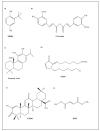The Nrf2-ARE pathway: a valuable therapeutic target for the treatment of neurodegenerative diseases
- PMID: 22742419
- PMCID: PMC3625035
- DOI: 10.2174/157488912803252023
The Nrf2-ARE pathway: a valuable therapeutic target for the treatment of neurodegenerative diseases
Abstract
Modulation of NF-E2 related factor 2 (Nrf2) has been shown in several neurodegenerative disorders. The overexpression of Nrf2 has become a potential therapeutic avenue for various neurodegenerative disorders such as Parkinson, Amyotrophic lateral sclerosis, and Alzheimer's disease. The expression of phase II detoxification enzymes is governed by the cis-acting regulatory element known as antioxidant response element (ARE). The transcription factor Nrf2 binds to ARE thereby transcribing multitude of antioxidant genes. Keap1, a culin 3-based E3 ligase that targets Nrf2 for degradation, sequesters Nrf2 in cytoplasm. Disruption of Keap1-Nrf2 interaction or genetic overexpression of Nrf2 can increase the endogenous antioxidant capacity of the brain thereby rendering protection against oxidative stress in neurodegenerative disorders. This review primarily focuses on recent patents that target Nrf2 overexpression as a promising therapeutic strategy for the treatment of neurodegenerative disorders.
Figures


Similar articles
-
Counteracting role of nuclear factor erythroid 2-related factor 2 pathway in Alzheimer's disease.Biomed Pharmacother. 2020 Sep;129:110373. doi: 10.1016/j.biopha.2020.110373. Epub 2020 Jun 27. Biomed Pharmacother. 2020. PMID: 32603894 Review.
-
Selenepezil, a Selenium-Containing Compound, Exerts Neuroprotective Effect via Modulation of the Keap1-Nrf2-ARE Pathway and Attenuates Aβ-Induced Cognitive Impairment in Vivo.ACS Chem Neurosci. 2019 Jun 19;10(6):2903-2914. doi: 10.1021/acschemneuro.9b00106. Epub 2019 May 13. ACS Chem Neurosci. 2019. PMID: 31035749
-
An Overview of the Nrf2/ARE Pathway and Its Role in Neurodegenerative Diseases.Int J Mol Sci. 2021 Sep 4;22(17):9592. doi: 10.3390/ijms22179592. Int J Mol Sci. 2021. PMID: 34502501 Free PMC article. Review.
-
The Keap1-Nrf2-ARE Pathway As a Potential Preventive and Therapeutic Target: An Update.Med Res Rev. 2016 Sep;36(5):924-63. doi: 10.1002/med.21396. Epub 2016 May 18. Med Res Rev. 2016. PMID: 27192495 Review.
-
Curcuminoids in neurodegenerative diseases.Recent Pat CNS Drug Discov. 2012 Dec;7(3):184-204. doi: 10.2174/157488912803252032. Recent Pat CNS Drug Discov. 2012. PMID: 22742420 Review.
Cited by
-
Antioxidant Defense Mechanisms in Erythrocytes and in the Central Nervous System.Antioxidants (Basel). 2019 Feb 18;8(2):46. doi: 10.3390/antiox8020046. Antioxidants (Basel). 2019. PMID: 30781629 Free PMC article. Review.
-
Therapeutic Potential of Vital Transcription Factors in Alzheimer's and Parkinson's Disease With Particular Emphasis on Transcription Factor EB Mediated Autophagy.Front Neurosci. 2021 Dec 14;15:777347. doi: 10.3389/fnins.2021.777347. eCollection 2021. Front Neurosci. 2021. PMID: 34970114 Free PMC article. Review.
-
Behavioral and histological assessment of a novel treatment of neuroHIV in humanized mice.Res Sq [Preprint]. 2023 Dec 13:rs.3.rs-3678629. doi: 10.21203/rs.3.rs-3678629/v1. Res Sq. 2023. PMID: 38168407 Free PMC article. Preprint.
-
Nrf2/HO-1 Signaling Activator Acetyl-11-keto-beta Boswellic Acid (AKBA)-Mediated Neuroprotection in Methyl Mercury-Induced Experimental Model of ALS.Neurochem Res. 2021 Nov;46(11):2867-2884. doi: 10.1007/s11064-021-03366-2. Epub 2021 Jun 1. Neurochem Res. 2021. PMID: 34075522
-
Neuroprotection of Andrographolide Against Microglia-Mediated Inflammatory Injury and Oxidative Damage in PC12 Neurons.Neurochem Res. 2019 Nov;44(11):2619-2630. doi: 10.1007/s11064-019-02883-5. Epub 2019 Sep 27. Neurochem Res. 2019. PMID: 31562575
References
-
- Halliwell B. Role of free radicals in the neurodegenerative diseases: therapeutic implications for antioxidant treatment. Drugs Aging. 2001;18:685–716. - PubMed
-
- Aksenov MY, Aksenova MV, Butterfield DA, Geddes JW, Markesbery WR. Protein oxidation in the brain in Alzheimer’s disease. Neuroscience. 2001;103:373–83. - PubMed
-
- Lovell MA, Gabbita SP, Markesbery WR. Increased DNA oxidation and decreased levels of repair products in Alzheimer’s disease ventricular CSF. J Neurochem. 1999;72:771–6. - PubMed
-
- Halliwell B. Oxidative stress and neurodegeneration: where are we now? J Neurochem. 2006;97:1634–58. - PubMed
Publication types
MeSH terms
Substances
Grants and funding
LinkOut - more resources
Full Text Sources
Other Literature Sources
Medical
